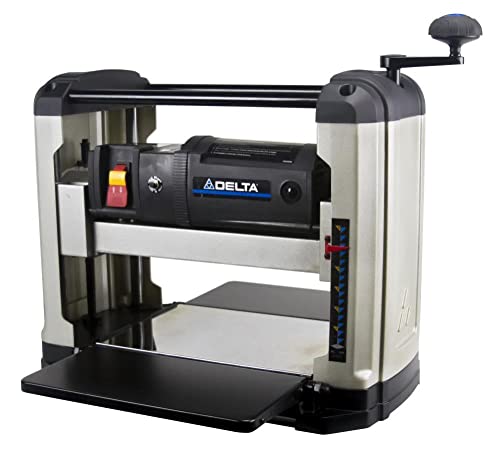Most woodworkers are familiar with the tools, but they may not know the exact difference between a planer vs jointer.






All good woodworking projects start with a 4×4 lumber, which has smooth faces and edges that are perfectly square and parallel to each other.
Lumber can be milled in a variety of ways, but the most straightforward and effective method is to use a power planer and jointer.
Hand-milling is a great art in and of itself, and something that all woodworkers should learn to master at some point.
It’s common to hear people refer to the tools as a planer or jointer, but this is incorrect. They’re two separate and entirely different tools.
So, what exactly is the distinction between a planer vs jointer? We’ll go into what each tool can do in this article, as well as their particular roles.
Planer vs Jointer: Quick Overview
We always get the same question: do I need both a jointer and a planer? Is it possible to use a jointer instead of a planer?
In certain ways, a jointer and a planer aren’t necessary. (Any more than a circular and a table saw are required.)
Using both materials, however, is the best way to get perfectly square, co-planar lumber unless you’ve mastered the art of hand-milling.
However, given their expenses and the amount of room they take up in the garage, many people wonder whether they can get away with buying one or the other.
You may get pretty close with only a planer and a circular or table saw (as many DIY enthusiasts and professional woodworkers do), but it’ll never be exact.
Differences Between Planer vs Jointer
The jointer is used first to give a new, unmilled piece of lumber one flat, square edge and one smooth, square face.
This isn’t as simple as tossing the piece onto the table and going over it; you’ll need a good eye for detecting the stock’s grain and natural cup orientation, as these will dictate which part of the board is jointed initially and which direction it needs to move along the jointer table.
Jointer blades rotate clockwise, so cut ‘with’ the grain whenever possible.
The jointer should leave you with one entirely flat face and one fully square edge if done correctly. (You should always joint the face first; a perfectly square edge can only be achieved if the face is totally flat and flush against the fence.)
Opposite Face And Edge
This is the purpose of the planner; it ensures that the board’s faces and edges are parallel to each other, or co-planar.
You’d get 2 perfectly flat faces if you used the jointer on both sides of the frame, but they wouldn’t be parallel to each other, leaving you with a wedge-shaped frame that’s thicker on one end compared to the other.
So, if you’re wondering if you should get away with using only one tool or both, you are better off using just the planer instead of the jointer.
To be honest, you can accomplish a lot with just a planer.
Most lumber you’ll buy has already been milled, which means it’ll be fairly smooth and reasonably (but not perfectly) straight.
You may use the planer to make passes on each face of the board until you have 2 square, parallel sides with the thickness you are looking for.
It’s hard to get square edges using a planer, but you can trim them with a circular or table saw and attain pretty good results. You can only get 1 flat face and 1 square edge with the help of a jointer.
Best Wood Planers And Jointers In 2025
If you’re ready to step up your game and invest in a planer or jointer (or both), here’s a list of tools that we think are the best options – reliable, high-quality tools you can rely on to deliver good results.
Keep in mind that if you are planning to buy just one, we recommend getting a planer first; you can do a lot of projects with it on its own, and you can still add a jointer later.
- Delta 13″ Planer (22-555) – Most Affordable Planer
- DeWalt 15A 12.5” Benchtop Planer (DW734) – Best Benchtop Planer
- Ridgid Planer (JP0610), 6 1/8” Jointer – High-Performance Planer
- Makita 12” Planer With Automated Head Clamp (2012NB) – Best Quality Planer
- Delta 6” Bench Top Jointer (37-071) – Best Budget Jointer
- Jet 10″ Bench-Top Jointer/Planer (JJP-10BTOS) – Best Planer Jointer Combo
Best Wood Planers And Jointers Review
1. Delta 13″ Planer (22-555) – Most Affordable Planer
Our pick for a low-cost alternative would be the Delta 22-555 power tool. If you really want to add a planer to your work setup but don’t want to break the bank, this Delta is a great option.
If you just have a limited budget for a planer, you may not be able to get the best tool available, but we’ve used similar low-cost planers before and this one tops them all.
It has an infeed table support of 6 3/4” and outfield support of 13” and can take stock up to 13” width and 6” depth.
What we like the most about this tool is how easy it is to adjust, manage, and operate; it’s really user-friendly with no-frills.
2. DeWalt 15A 12.5” Benchtop Planer (DW734) – Best Benchtop Planer
For non-professionals and DIY enthusiasts, this is the preferred option.
It’s a remarkably dependable tool that works very well, and it’s a fraction of the price of more expensive, commercial-quality planers that can cost thousands of dollars.
It has a maximum cut depth of 1/8” and can plane wood up to 33.5” L X 6” D X 12.5” H. This is a user-friendly, super-convenient unit that’s ideal for DIY enthusiasts.
You might also be interested in checking out the best benchtop jointer.
3. Ridgid Planer (JP0610), 6 1/8” Jointer – High-Performance Planer
A fantastic tool that Ridgid has discontinued – as is common with major power tools that have been discontinued, the ‘new-in-box’ price goes up until they are no longer available.
This is unreasonable and unfair to the customer, but we had to include it because it is an impressive product that outperforms some of the other models mentioned on this list. It has a 6×18” bed and an adjustable fence for beveled edges at 450, 900, and 1350.
4. Makita 12” Planer With Automated Head Clamp (2012NB) – Best Quality Planer
The quality is slightly higher than the DeWalt DW734, but you get what you pay for.
This is probably the best tool you’ll find for DIY settings and woodworking projects. It has a maximum thickness of 6 3/32” (just a bit more than the DeWalt) and a maximum width of 12”.
It has a two-knife cutting board (the DeWalt comes with a three-knife) that is easy to adjust and replace, and it can fit parts up to 30 3/8″ in length.
The DeWalt can work with slightly bigger boards, but the Makita’s cut consistency is better based on our experience (here are the best electric hand planers).
5. Delta 6” Bench Top Jointer (37-071) – Best Budget Jointer
At just over $300, it’s the most cost-effective option on the list.
Delta seems to have a knack for creating pretty basic, no-frills tools that are user-friendly for the average consumer, much like their planer. Adjustable fence for 450 beveled cuts and a maximum depth cut of 1/8”.
6. Jet 10″ Bench-Top Jointer/Planer (JJP-10BTOS) – Best Planer Jointer Combo
No products found.
We believe this is the largest ‘budget’ jointer available. (The majority of DIY project planers are 6” or 8”). Again, don’t let the price be the deciding factor: you get the quality you pay for.
Although professional woodworkers may not consider this for their store, it’s a great deal for DIY enthusiasts looking to add a big-sized planer to their tool kit.
Jet also offers the JJP-8BT 8” Jointer/Planer for a little less. Both are great options that will get you a jointer for a reasonable price.
Conclusion
We have discussed the differences between a planer vs jointer and these are large power tools that only serious craftsmen, woodworkers, or DIY enthusiasts consider purchasing.
Quality woodworking requires properly milled lumber, and these tools are the most dependable and foolproof way to 4×4 your stock.
Here are the 6 best wood planers and jointers available on the market:
- Delta 13″ Planer (22-555) – Most Affordable Planer
- DeWalt 15A 12.5” Benchtop Planer (DW734) – Best Benchtop Planer
- Ridgid Planer (JP0610), 6 1/8” Jointer – High-Performance Planer
- Makita 12” Planer With Automated Head Clamp (2012NB) – Best Quality Planer
- Delta 6” Bench Top Jointer (37-071) – Best Budget Jointer
- Jet 10″ Bench-Top Jointer/Planer (JJP-10BTOS) – Best Planer Jointer Combo
Be sure to check out our comparison guide for 10″ vs 12″ miter saw.


